How to 100% pass 70-458 exam? GreatExam offers you all the 70-458 exam questions and answers which are the same as your real test with 100% correct and coverage rate. Our 70-458 practice test is unparalleled in quality and is 100% guaranteed to make you pass 70-458 exam. All the 70-458 prepare material are the latest. Here are some free share of Microsoft 70-458 dumps.
QUESTION 41
Drag and Drop Question
You are developing a SQL Server Integration Services (SSIS) package that imports unsorted data into a data warehouse hosted on SQL Azure.
You have the following requirements:
– A destination table must contain all of the data in two source tables.
– Duplicate records must be inserted into the destination table.
You need to develop a data flow that imports the data while meeting the requirements.
How should you develop the data flow? (To answer, drag the appropriate transformation from the list of transformations to the correct location in the answer area.)
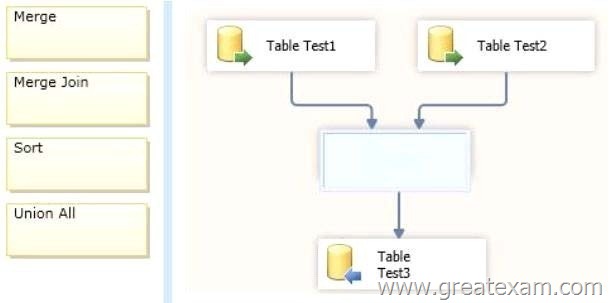
Answer: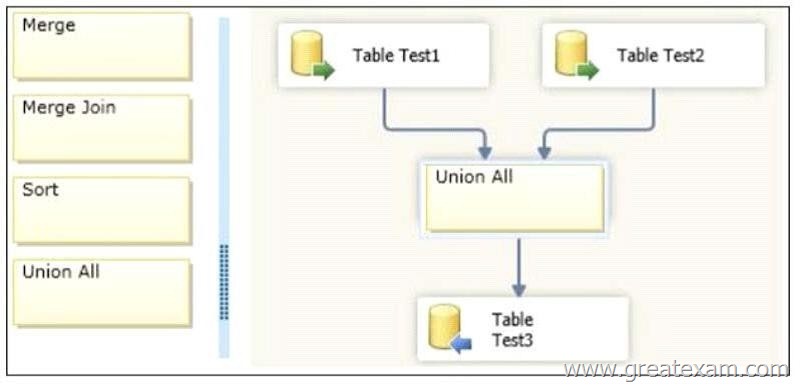
Explanation:
http://msdn.microsoft.com/en-us/library/ms141703.aspx
http://msdn.microsoft.com/en-us/library/ms141775.aspx
http://msdn.microsoft.com/en-us/library/ms141020.aspx
http://msdn.microsoft.com/en-us/library/ms140182.aspx
QUESTION 42
You are completing the installation of the Data Quality Server component of SQL Server Data Quality Services (DQS).
You need to complete the post-installation configuration.
What should you do?
A. Run the dbimpexp.exe command.
B. Install the data providers that are used for data refresh.
C. Run the DQSInstalIer.exe command.
D. Install the Analysis Services OLE DB Provider.
Answer: C
Explanation:
http://msdn.microsoft.com/en-us/library/ff877917.aspx
http://msdn.microsoft.com/en-us/library/gg492277.aspx
QUESTION 43
You are using the Knowledge Discovery feature of the Data Quality Services (DQS) client application to modify an existing knowledge base.
In the mapping configuration, two of the three columns are mapped to existing domains in the knowledge base. The third column, named Team Type, does not yet have a domain.
You need to complete the mapping of the Team Type column.
What should you do?
A. Add a column mapping for the Team Type column.
B. Add a domain for the Team Type column.
C. Map a composite domain to the source column.
D. Create a composite domain that includes the Team Type column.
Answer: B
Explanation:
http://msdn.microsoft.com/en-us/library/ff877917.aspx
http://msdn.microsoft.com/en-us/library/hh213015.aspx
http://msdn.microsoft.com/en-us/library/gg524799.aspx
QUESTION 44
You are creating a SQL Server Master Data Services (MDS) mode).
This model is used to store a master list of products. An attribute must be added to the Product entity to define the sales manager responsible for each product.
You need to create an attribute in the Product entity that prevents users from entering invalid sales manager values.
Which type of attribute should you create?
A. Derived
B. Domain-based
C. User-defined
D. Parent
E. Explicit
F. Recursive
Answer: B
Explanation:
http://msdn.microsoft.com/en-us/library/bb190163.aspx
http://msdn.microsoft.com/en-us/library/ee633737.aspx
http://msdn.microsoft.com/en-us/library/ee633759.aspx
http://msdn.microsoft.com/en-us/library/ee633745.aspx
http://msdn.microsoft.com/en-us/library/ee633724.aspx
http://msdn.microsoft.com/en-us/library/ee633733.aspx
http://msdn.microsoft.com/en-us/library/ff487058.aspx
QUESTION 45
You develop a SQL Server Integration Services (SSIS) package that imports SQL Azure data into a data warehouse every night.
The SQL Azure data contains many misspellings and variations of abbreviations.
To import the data, a developer used the Fuzzy Lookup transformation to choose the closest-matching string from a reference table of allowed values.
The number of rows in the reference table is very large.
If no acceptable match is found, the Fuzzy Lookup transformation passes a null value.
The current setting for the Fuzzy Lookup similarity threshold is 0.50.
Many values are incorrectly matched.
You need to ensure that more accurate matches are made by the Fuzzy Lookup transformation without degrading performance.
What should you do?
A. Decrease the maximum number of matches per lookup.
B. Change the similarity threshold to 0.55.
C. Change the Exhaustive property to True.
D. Increase the maximum number of matches per lookup.
Answer: B
Explanation:
The similarity thresholds can be set at the component and join levels.
The join-level similarity threshold is only available when the transformation performs a fuzzy match between columns in the input and the reference table.
The similarity range is 0 to 1. The closer to 1 the threshold is, the more similar the rows and columns must be to qualify as duplicates.
http://msdn.microsoft.com/en-us/library/ms137786.aspx
QUESTION 46
You are designing a data warehouse hosted on SQL Azure.
The data warehouse currently includes the dimllser and dimDistrict dimension tables and the factSales fact table. The dimUser table contains records for each user permitted to run reports against the warehouse, and the dimDistrict table contains information about sales districts.
The system is accessed by users from certain districts, as well as by area supervisors and users from the corporate headquarters.
You need to design a table structure to ensure that certain users can see sales data for only certain districts.
Some users must be permitted to see sales data from multiple districts.
What should you do?
A. Create a userDistrict table that contains primary key columns from the dimUser and dimDistrict tables.
B. Partition the factSales table on the district column.
C. Add a district column to the dimUser table.
D. For each district, create a view of the factSales table that includes a WHERE clause for the district.
Answer: A
QUESTION 47
Drag and Drop Question
You are creating a sales data warehouse.
When a product exists in the product dimension, you update the product name.
When a product does not exist, you insert a new record.
In the current implementation, the DimProduct table must be scanned twice, once for the insert and again for the update.
As a result, inserts and updates to the DimProduct table take longer than expected.
You need to create a solution that uses a single command to perform an update and an insert. How should you use a MERGE T-SQL statement to accomplish this goal? (To answer, drag the appropriate answer choice from the list of options to the correct location or locations in the answer area. You may need to drag the split bar between panes or scroll to view content.)
Answer:
Explanation:
http://msdn.microsoft.com/en-us/library/bb510625.aspx
http://msdn.microsoft.com/en-us/library/cc280522.aspx
QUESTION 48
You develop three Microsoft SQL Server 2012 databases named Database1, Database2, and Database3.
You have permissions on both Database1 and Database2.
You plan to write and deploy a stored procedure named dbo.usp_InsertEvent in Database3. dbo.usp_InsertEvent must execute other stored procedures in the other databases.
You need to ensure that callers that do not have permissions on Database1 or Database2 can execute the stored procedure.
Which Transact-SQL statement should you use?
A. USE Database2
B. EXECUTE AS OWNER
C. USE Database1
D. EXECUTE AS CALLER
Answer: B
Explanation:
http://msdn.microsoft.com/en-us/library/ms188354.aspx http://blog.sqlauthority.com/2007/10/06/sql-server-executing-remote-stored-procedure-calling- storedprocedure-on-linked-server/
QUESTION 49
You administer a Microsoft SQL Server 2012 failover cluster that contains two nodes named Node A and Node B.
A single instance of SQL Server is installed on the cluster.
An additional node named Node C has been added to the existing cluster.
You need to ensure that the SQL Server instance can use all nodes of the cluster.
What should you do?
A. Create a ConfigurationFile.ini file from Node B, and then run the AddNode command-line tool on Node A.
B. Use Node A to install SQL Server on Node C.
C. Run the Add Node to SQL Server Failover Cluster Wizard on Node C.
D. Use Cluster Administrator to add a new Resource Group to Node B.
Answer: C
Explanation:
http://msdn.microsoft.com/en-us/library/hh231721.aspx
http://msdn.microsoft.com/en-us/library/ms189134.aspx
QUESTION 50
Drag and Drop Question
You administer three Microsoft SQL Server 2012 servers named ServerA, ServerB, and ServerC. ServerA is the acting principal and ServerB is the mirror.
You need to add ServerC as a witness to the existing mirroring session between ServerA and ServerB.
You need to achieve this goal without delaying synchronization.
Which three actions should you perform in sequence? (To answer, move the appropriate actions from the list of actions to the answer area and arrange them in the correct order.)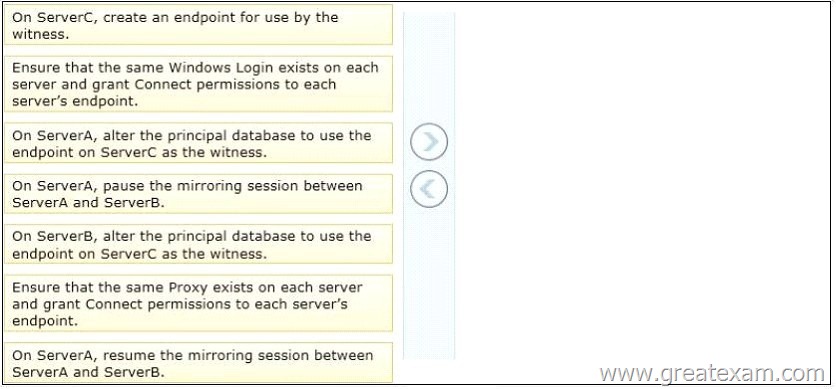
Answer: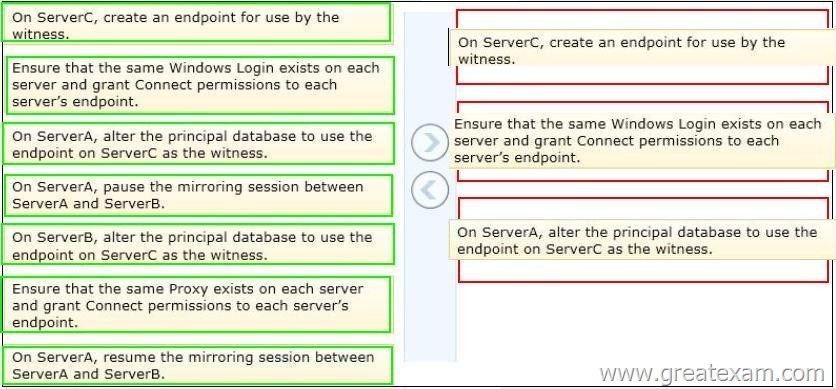
Explanation:
http://msdn.microsoft.com/en-us/library/ms190430.aspx
QUESTION 51
Drag and Drop Question
You administer three Microsoft SQL Server 2008 R2 instances.
Database mirroring is configured in High-Safety mode with Automatic Failover between the following three servers:
– SQL1 is the Principal server.
– SQL2 is the mirror server.
– SQL3 is the witness server.
You need to upgrade SQL1 and SQL2 to SQL Server 2012.
You need to ensure that downtime is minimized during the upgrade.
Which six actions should you perform in sequence? (To answer, move the appropriate actions from the list of actions to the answer area and arrange them in the correct order.)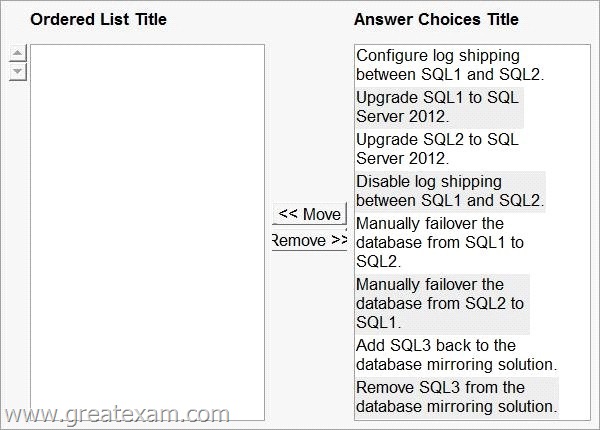
Answer: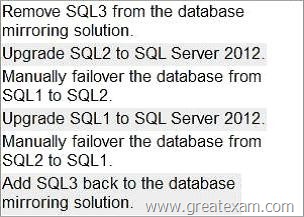
QUESTION 52
You administer a Microsoft SQL Server 2012 instance that contains a financial database hosted on a storage area network (SAN).
The financial database has the following characteristics:
– A data file of 2 terabytes is located on a dedicated LUN (drive D).
– A transaction log of 10 GB is located on a dedicated LUN (drive E).
– Drive D has 1 terabyte of free disk space.
– Drive E has 5 GB of free disk space.
The database is continually modified by users during business hours from Monday through Friday between 09:00 hours and 17:00 hours. Five percent of the existing data is modified each day. The Finance department loads large CSV files into a number of tables each business day at 11:15 hours and 15:15 hours by using the BCP or BULK INSERT commands.
Each data load adds 3 GB of data to the database.
These data load operations must occur in the minimum amount of time.
A full database backup is performed every Sunday at 10:00 hours. Backup operations will be performed every two hours (11:00, 13:00, 15:00, and 17:00) during business hours.
You need to ensure that the minimum amount of data is lost.
Which recovery model should the database use?
A. FULL
B. DBO_ONLY
C. CONTINUE_AFTER_ERROR
D. CHECKSUM
E. NO_CHECKSUM
F. SIMPLE
G. Transaction log
H. SKIP
I. RESTART
J. COPY_ONLY
K. NORECOVERY
L. BULK_LOGGED
M. Differential
N. STANDBY
Answer: A
Explanation:
This seems to be a trick question. In order to minimize the amount of data loss, we use Full recovery model. BulkLogged model has the potential for some data loss.
According to this logic (and the below reference), this answer looks correct.
http://msdn.microsoft.com/en-us/library/ms189275.aspx
QUESTION 53
You administer a SQL Server 2012 server that contains a database named SalesDb.
SalesDb contains a schema named Customers that has a table named Regions.
A user named UserA is a member of a role named Sales.
UserA is granted the Select permission on the Regions table.
The Sales role is granted the Select permission on the Customers schema.
You need to ensure that UserA is disallowed to select from any of the tables in the Customers schema.
Which Transact-SQL statement should you use?
A. DENY SELECT ON Object::Regions FROM UserA
B. DENY SELECT ON Object::Regions FROM Sales
C. REVOKE SELECT ON Schema::Customers FROM Sales
D. REVOKE SELECT ON Schema::Customers FROM UserA
E. REVOKE SELECT ON Object::Regions FROM Sales
F. REVOKE SELECT ON Object::Regions FROM UserA
G. DENY SELECT ON Schema::Customers FROM Sales
H. DENY SELECT ON Schema::Customers FROM UserA
I. EXEC sp_addrolemember ‘Sales’, ‘UserA’
J. EXEC sp droprolemember ‘Sales’, ‘UserA’
Answer: H
Explanation:
http://msdn.microsoft.com/en-us/library/ms188369.aspx
http://msdn.microsoft.com/en-us/library/ms187750.aspx
http://msdn.microsoft.com/en-us/library/ff848791.aspx
QUESTION 54
Drag and Drop Question
You administer two Microsoft SQL Server 2012 servers named ServerA and ServerB.
You use a database named AdventureWorks.
You need to prepare the AdventureWorks database for database mirroring.
ServerB will act as the mirror in a mirroring partnership along with ServerA.
Which three actions should you perform in sequence? (To answer, move the appropriate actions from the list of actions to the answer area and arrange them in the correct order.)
Answer: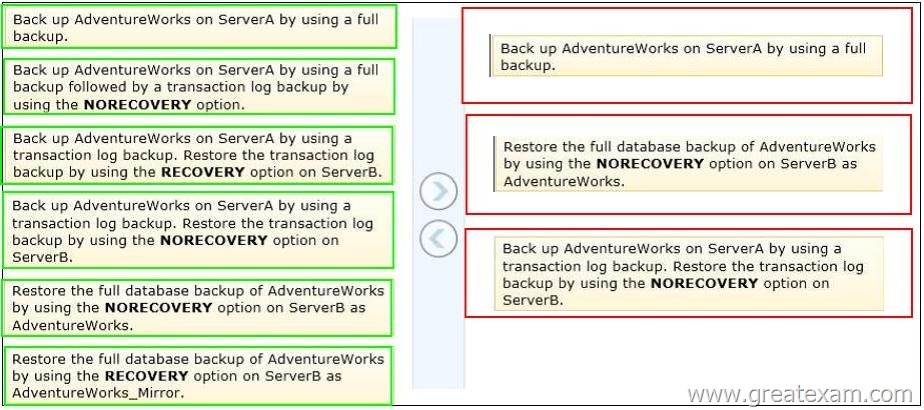
Explanation:
http://msdn.microsoft.com/en-us/library/ms190941.aspx
http://msdn.microsoft.com/en-us/library/ms189852.aspx
QUESTION 55
You administer a Microsoft SQL Server 2012 database named ContosoDb.
The database contains a table named Suppliers and a column named IsActive in the Purchases schema.
You create a new user named ContosoUser in ContosoDb.
ContosoUser has no permissions to the Suppliers table.
You need to ensure that ContosoUser can delete rows that are not active from Suppliers.
You also need to grant ContosoUser only the minimum required permissions.
Which Transact-SQL statement should you use?
A. GRANT DELETE ON Purchases.Suppliers TO Contoso User
B. CREATE PROCEDURE Purchases.PurgeInactiveSuppliers
WITH EXECUTE AS USER = ‘dbo’
AS
DELETE FROM Purchases.Suppliers WHERE IsActive = 0
GO
GRANT EXECUTE ON Purchases.PurgelnactiveSuppliers TO ContosoUser
C. GRANT SELECT ON Purchases.Suppliers TO ContosoUser
D. CREATE PROCEDURE Purchases.PurgeInactiveSuppliers
AS
DELETE FROM Purchases.Suppliers WHERE IsActive = 0
GO
GRANT EXECUTE ON Purchases.PurgeInactiveSuppliers TO ContosoUser
Answer: B
Explanation:
http://msdn.microsoft.com/en-us/library/ms188354.aspx
http://msdn.microsoft.com/en-us/library/ms187926.aspx
QUESTION 56
You administer a Microsoft SQL Server 2012 database that contains a table named OrderDetail. You discover that the NCI_OrderDetail_CustomerID non-clustered index is fragmented.
You need to reduce fragmentation.
You need to achieve this goal without taking the index offline.
Which Transact-SQL batch should you use?
A. CREATE INDEX NCI_OrderDetail_CustomerID ON OrderDetail.CustomerID WITH DROP EXISTING
B. ALTER INDEX NCI_OrderDetail_CustomerID ON OrderDetail.CustomerID REORGANIZE
C. ALTER INDEX ALL ON OrderDetail REBUILD
D. ALTER INDEX NCI_OrderDetail_CustomerID ON OrderDetail.CustomerID REBUILD
Answer: B
Explanation:
http://msdn.microsoft.com/en-us/library/ms188388.aspx
QUESTION 57
You administer all the deployments of Microsoft SQL Server 2012 in your company.
You need to ensure that an OLTP database that uses a storage area network (SAN) remains available if any of the servers fail.
You also need to minimize the amount of storage used by the database.
Which configuration should you use?
A. Two servers configured in different data centers
SQL Server Availability Group configured in Synchronous-Commit Availability Mode
One server configured as an Active Secondary
B. SQL Server that includes an application database configured to perform transactional
replication
C. Two servers configured in the same data center
SQL Server Availability Group configured in Asynchronous-Commit Availability Mode
One server configured as an Active Secondary
D. Two servers configured in different data centers
SQL Server Availability Group configured in Asynchronous-Commit Availability Mode
E. Two servers configured in the same data center
A primary server configured to perform log-shipping every 10 minutes A backup server
configured as a warm standby
F. Two servers configured on the same subnet
SQL Server Availability Group configured in Synchronous-Commit Availability Mode
G. SQL Server that includes an application database configured to perform snapshot replication
H. Two servers configured in a Windows Failover Cluster in the same data center
SQL Server configured as a clustered instance
Answer: H
Explanation:
http://msdn.microsoft.com/en-us/library/ff650328.aspx
http://msdn.microsoft.com/en-us/library/ms189134
http://msdn.microsoft.com/en-us/library/hh750283.aspx
http://msdn.microsoft.com/en-us/library/ff878716.aspx
QUESTION 58
You administer all the deployments of Microsoft SQL Server 2012 in your company.
A database contains a large product catalog that is updated periodically.
You need to be able to send the entire product catalog to all branch offices on a monthly basis. Which configuration should you use?
A. Two servers configured in the same data center
A primary server configured to perform log-shipping every 10 minutes
A backup server configured as a warm standby
B. Two servers configured in the same data center
SQL Server Availability Group configured in Asynchronous-Commit Availability Mode
One server configured as an Active Secondary
C. SQL Server that includes an application database configured to perform snapshot replication
D. Two servers configured in different data centers
SQL Server Availability Group configured in Synchronous-Commit Availability Mode
One server configured as an Active Secondary
E. Two servers configured on the same subnet
SQL Server Availability Group configured in Synchronous-Commit Availability Mode
F. Two servers configured in different data centers
SQL Server Availability Group configured in Asynchronous-Commit Availability Mode
G. SQL Server that includes an application database configured to perform transactional replication
H. Two servers configured in a Windows Failover Cluster in the same data center
SQL Server configured as a clustered instance
Answer: C
Explanation:
http://msdn.microsoft.com/en-us/library/ms151832.aspx
QUESTION 59
You administer all the deployments of Microsoft SQL Server 2012 in your company.
You need to ensure that data changes are sent to a non-SQL Server database server in near real time.
You also need to ensure that data on the primary server is unaffected.
Which configuration should you use?
A. SQL Server that includes an application database configured to perform transactional replication
B. Two servers configured in different data centers
SQL Server Availability Group configured in Asynchronous-Commit Availability Mode
C. Two servers configured in different data centers
SQL Server Availability Group configured in Synchronous-Commit Availability Mode
One server configured as an Active Secondary
D. SQL Server that includes an application database configured to perform snapshot replication
E. Two servers configured in the same data center
SQL Server Availability Group configured in Asynchronous-Commit Availability Mode
One server configured as an Active Secondary
F. Two servers configured on the same subnet
SQL Server Availability Group configured in Synchronous-Commit Availability Mode
G. Two servers configured in a Windows Failover Cluster in the same data center
SQL Server configured as a clustered instance
H. Two servers configured in the same data center
A primary server configured to perform log-shipping every 10 minutes
A backup server configured as a warm standby
Answer: A
Explanation:
http://technet.microsoft.com/en-us/library/ms151738.aspx
QUESTION 60
You administer all the deployments of Microsoft SQL Server 2012 in your company.
You need to ensure that an OLTP database that includes up-to-the-minute reporting requirements can be off- loaded from the primary database to another server.
You also need to be able to add indexes to the secondary database.
Which configuration should you use?
A. Two servers configured in different data centers
SQL Server Availability Group configured in Synchronous-Commit Availability Mode
One server configured as an Active Secondary
B. Two servers configured in the same data center
SQL Server Availability Group configured in Asynchronous-Commit Availability Mode
One server configured as an Active Secondary
C. Two servers configured in the same data center
A primary server configured to perform log-shipping every 10 minutes
A backup server configured as a warm standby
D. Two servers configured in different data centers
SQL Server Availability Group configured in Asynchronous-Commit Availability Mode
E. Two servers configured on the same subnet
SQL Server Availability Group configured in Synchronous-Commit Availability Mode
F. SQL Server that includes an application database configured to perform transactional replication
G. SQL Server that includes an application database configured to perform snapshot replication
H. Two servers configured in a Windows Failover Cluster in the same data center
SQL Server configured as a clustered instance
Answer: A
Explanation:
http://msdn.microsoft.com/en-us/library/ff878253.aspx
GreatExam 70-458 Questions & Answers covers all the knowledge points of the real exam. We update our product frequently so our customer can always have the latest version of the braindumps. We have the most professional expert team to back up our grate quality products. Welcome to try.